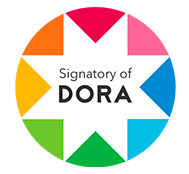Types of Musical Interaction in the Family and Everyday Context
Bruna's musical relationship with her parents
DOI:
https://doi.org/10.24215/18530494e052Keywords:
early childhood education, music education, music activities, family life, LENA, graphic representationsAbstract
In the field of Early Childhood Education, musical communication between adults and children has been recurrently studied. Most research on this topic has prioritized the adult perspective when observing the interaction with the infant, which has led to an incomplete characterization of this phenomenon. The present qualitative and emergent study has adopted the audio recording technology LENA® (Language ENvironment Analysis) to document real situations from the daily life of five families with at least one child, and to know the type of parental-child participation in everyday musical and vocal interactions, primarily the contextual, musical, and communicative elements that compose them. This article presents the results of one of the participating families through descriptions of their musical encounters that exemplify six types of interactions (dialogue, synchrony, solo, fill the gap, imitation, and contrast) detected with an analysis tool designed and validated for this research. These descriptions are accompanied by graphic representations that visualize the interventions of each participant and give a deeper understanding of the individual behaviors of both adult and infant within the same phenomenon that is participatory and shared.
References
Addessi, A. R. (2009). The musical dimension of daily routines with under‐four children during diaper change, bedtime, and free play. Early Child Development and Care, 179 (6), 747-768. https://doi.org/10.1080/03004430902944122
Aguirre, A. (Ed.) (1995). Etnografía: Metodología Cualitativa en la investigación Sociocultural. Marcombo.
Bainbridge, C. M., Bertolo, M., Youngers, J., Atwood, S., Yurdum, L., Simson, J., Lopez, K., Feng, X., Martin, A. y Mehr, S. A. (2021). Infants relax in response to unfamiliar foreign lullabies. Nature Human Behaviour, 5(2), 256–264. https://doi.org/10.1038/s41562-020-00963-z
Blackburn, C. (2017). Young children’s musical activities in the home. Education 3-13, 45(6), 674-688. https://doi.org/10.1080/ 03004279.2017.1342320
Blacking, J. (2006). ¿Hay música en el hombre? Alianza Editorial.
Bullowa, M. (Ed.). (1979). Before speech: The beginning of human communication. Cambridge University Press.
Costa-Giomi, E. y Benetti, L. (2017). Through a baby’s ears: Musical interactions in a family community. International Journal of Community Music, 10(3), 289-303. https://doi.org/10.1386/ijcm.10.3.289_1
Costa-Giomi, E. y Sun, X. (2016). Infants’ home soundscape: A day in the life of a family. En J. Bugos (Ed.), Contemporary Research in Music Learning Across the Lifespan (pp. 99-108). Routledge.
Cross, I. y Morley, I. (2009). The evolution of music: Theories, definitions and the nature of the evidence. En S. Malloch y C. Trevarthen, (Eds.), Communicative Musicality. Exploring the basis of human companionship (pp. 61–81). Oxford University Press.
Custodero, L. A. (2006). Singing practices in 10 families with young children. Journal of Research in Music Education, 54(1), 37-56. https://doi.org/10.1177/002242940605400104
Custodero, L. A., Britto, P. R. y Xin, T. (2002). From Mozart to Motown, lullabies to love songs: A preliminary report on the parents' use of music with infant survey (PUMIS). Zero to Three, 23(1), 41-46.
Custodero, L. A. y Johnson-Green, E. A. (2003). Passing the cultural torch: Musical experience and musical parenting of infants. Journal of Research in Music Education, 51(2), 102-114. https://doi.org/10.2307/3345844
De Vries, P. (2009). Music at home with the under-fives: What is happening? Early Child Development and Care, 179(4), 395–405. https://doi.org/10.1080/03004430802691914
Dean, B. (2019). Spontaneous singing and musical agency in the everyday home lives of three and four-year-old children. En S. Young y B. Ilari (Eds.), Music in early childhood: Multi-disciplinary perspectives and inter-disciplinary exchanges (pp.103-118). Springer.
Denac, O. (2008). A Case Study of Preschool Children’s Musical Interests at Home and at School. Early Childhood Education Journal, 35(5), 439-444. https://doi.org/10.1007/s10643-007-0205-4
Dissanayake, E. (2000). Art and intimacy: How the arts began. University of Washington Press.
Dosaiguas, M. y Pérez-Moreno, J. (2021). Estudio exploratorio de las interacciones musicales entre hermanos/as en el entorno cotidiano. Revista Electrónica de LEEME, 48, 39-58. https://doi.org/10.7203/LEEME.48.21417
Dosaiguas, M., Pérez-Moreno, J., Gluschankof, C. y Costa-Giomi, E. (2021). Listening to a siblings’ day: musical interactions in a family setting. Early Child Development and Care, 191(12), 1843-1857. https://doi.org/10.1080/03004430.2020.1863392
Español, S. (2010). Performances en la infancia: cuando el habla parece música, danza y poesía. Epistemus. Revista de Estudios en Música, Cognición y Cultura, 1(1), 57-95. https://doi.org/10.21932/epistemus.1.2702.0
Español, S. y Shifres, F. (2015). The Artistic Infant Directed Performance: A Mycroanalysis of the Adult’s Movements and Sounds. Integrative Physiological and Behavioral Science, 49, 371–397. https://doi.org/10.1007/s12124-015-9308-4
Español, S., Shifres, F., Martínez, I. y Pérez, D. (2022). The Infant-Directed Improvised Performances: What They Are and What Happens Through Them. En S. Español, M. Martínez y F. G. Rodríguez (Eds.), Moving and Interacting in Infancy and Early Childhood: An Embodied, Intersubjective, and Multimodal Approach to the Interpersonal World (pp. 21-56). Springer Nature.
Frith, S. (2001). Hacia una estética de la música popular. En F. Cruces (Ed.), Las culturas musicales, Lecturas de etnomusicología (pp. 413-435). Trotta.
Gingras, P. (2012). Music at Home: A Portrait of Family Music-Making. [Tesis doctoral no publicada]. University of Rochester. https://urresearch.rochester.edu/file
Gordon, E. (2003). A music learning theory for newborn and young children. GIA Publications.
Hallam, S. (2015). The power of music: a research synthesis of the impact of actively making music on the intellectual, social, and personal development of children and young people. International Music Education Research Centre (iMerc).
Holler, J. y Levinson, S. (2019). Multimodal language processing in human communication. Trends in Cognitive Sciences, 23(8), 639-652. https://doi.org/10.1016/j.tics.2019.05.006
Ilari, B. (2005). On musical parenting of young children: Beliefs and behaviors of mothers and infants. Early Child Development and Care, 175(6-8), 647–660. https://doi.org/10.1080/0300443042000302573
Koops, L. H. (2014). Songs from the car seat: Exploring the early childhood music-making place of the family vehicle. Journal of Research in Music Education, 62(1), 52–65. https://doi.org/10.1177/0022429413520007
Koops, L. H. (2019). Parenting musically. Oxford University Press.
Lerma-Arregocés, D. y Pérez-Moreno, J. (2022). “Es dependiente al sonido de mi voz”. Percepciones maternas de las interacciones musicales cantadas entre madre e hijo. Revista Electrónica Complutense de Investigación en Educación Musical, 19, 27-37. https://dx.doi.org/10.5209/reciem.75464
Lerma-Arregocés, D. y Pérez-Moreno, J. (2023). Musical communication among parents and their children: An analysis tool to study their interaction. International Journal of Music Education, 0(0). https://doi.org/10.1177/02557614231174033
Loewy, J. V. (1995). The musical stages of speech: A developmental model of pre-verbal sound making. Music Therapy, 13(1), 47-73. https://doi.org/10.1093/mt/13.1.47
Malloch, S. (1999). Mothers and infants and communicative musicality. Musicae scientiae, 3(1 suppl), 29-57. https://doi.org/10.1177/10298649000030S104
Malloch, S. y Trevarthen, C. (Eds.). (2009). Communicative Musicality. Exploring the basis of human companionship. Oxford University Press.
Mehr, S. A. (2014). Music in the home: New evidence for an intergenerational link. Journal of Research in Music Education, 62(1), 78–88. https://doi.org/10.1177/0022429413520008
Mehr, S. A., Singh, M., Knox, D., Ketter, D. M., Pickens-Jones, D., Atwood, S., ..., Glowacki, L. (2019). Universality and diversity in human song. Science, 366(6468), eaax0868. https://doi.org/10.1126/science.aax0868
Nikolsky, A. (2020). Emergence of the Distinction Between “Verbal” and “Musical” in Early Childhood Development. En N. Masataka (Ed.), The Origins of Language Revisited (pp.139-215). Springer. https://doi.org/10.1007/978-981-15-4250-3_7
Perkins, M., Obrecht, C. y Adams, C. (2012). Canva (2.5) [Aplicación móvil]. Google play. https://play.google.com/store/apps/details?id=com.canva.editor
Provenzi, L., Scotto di Minico, G., Giusti, L., Guida, E. y Müller, M. (2018). Disentangling the dyadic dance: Theoretical, methodological and outcomes systematic review of mother-infant dyadic processes. Frontiers in Psychology, 9, 348. https://doi.org/10.3389/fpsyg.2018.00348
Shifres, F. (2008). Expresión musical en la voz cantada y hablada en interacciones adulto-infante. En M. de la P. Jacquier y A. Pereira Ghiena (Eds.), Objetividad-Subjetividad y Música. Actas de la VII Reunión Anual de SACCoM (pp. 83-93). SACCoM.
Simons, H. (2011). El estudio de caso: Teoría y práctica. Ediciones Morata.
Sole, M. (2014). Songs from de crib: toddlers’ private bedtime vocalizations. A collective case study. [Tesis Doctoral no publicada]. Columbia University. https://www.academia.edu/7819563/
Trehub, S. E. y Gudmundsdottir, H. R. (2015). Mothers as singing mentors for infants. En G. F. Welch, D. M. Howard y J. Nix (Eds.), The Oxford Handbook of Singing (pp. 455-470). Oxford University Press.
Trehub, S. E. y Prince, R. (2010). Lullabies and other women’s songs in the Turkish village of Akçaeniş. UNESCO Observatory E-journal, 2(1), 1–19.
Trehub, S. E. y Trainor, L. J. (1998). Singing to infants: lullabies and play songs. Advances in Infancy Research, 12, 43-77.
Trehub, S. E., Unyk, A. M., Kamenetsky, S. B., Hill, D. S., Trainor, L. J., Henderson, J. L. y Saraza, M. (1997). Mothers' and fathers' singing to infants. Developmental Psychology, 33(3), 500 -507. https://doi.org/10.1037/0012-1649.33.3.500
Trehub, S. E., Unyk, A. M. y Trainor, L. J. (1993). Adults identify infant-directed music across cultures. Infant Behavior and Development, 16, 193-211.
Trevarthen, C. y Bjørkvold, J. R. (2016). Life for Learning. En D. Narvaez, J. M. Braungart-Rieker, L. E. Miller-Graff, L. T. Gettler y P. D. Hastings (Eds.), Contexts for Young Child Flourishing: Evolution, Family, and Society (pp. 28-60). Oxford University Press.
Trevarthen, C. y Malloch, S. (2012). Musicality and musical culture: Sharing narratives of sound from early childhood. En G. McPherson y G. Welch (Eds.), Oxford handbook of music education (OHME) (pp. 248–260). Oxford University Press.
Welch, G. F. (2005). Singing as communication. En D. Miell, R. MacDonald y D. Hargreaves (Eds.), Musical Communication (pp. 239-259). Oxford University Press.
Williams, K. E., Barrett, M. S., Welch, G. F., Abad, V. y Broughton, M. (2015). Associations between early shared music activities in the home and later child outcomes: Findings from the Longitudinal Study of Australian Children. Early Childhood Research Quarterly, 31, 113–124. https://doi.org/10.1016/j.ecresq.2015.01.004
Wuytack, J. y Boal-Pelheiros, G. (2009). Audición Musical activa con el musicograma. Eufonía 47, 43-55. http://hdl.handle.net/10400.22/11323
Downloads
Published
Issue
Section
License
Copyright (c) 2023 Daniela Lerma Arregocés

This work is licensed under a Creative Commons Attribution-NonCommercial-ShareAlike 4.0 International License.
Politica vigente desde octubre de 2019
La aceptación del manuscrito por parte de la revista implica la cesión no exclusiva de los derechos patrimoniales de los/as autores/as en favor del editor, quien permite la reutilización, luego de su edición (postprint), bajo una Licencia Creative Commons Atribución-NoComercial-CompartirIgual 4.0 Internacional (CC BY-NC-SA 4.0)
Acorde a estos términos, el material se puede copiar y redistribuir en cualquier medio o formato siempre que a) se cite la autoría y la fuente original de su publicación (revista y URL de la obra), se brinde el acceso a la licencia y se indique si se realizaron cambios; b) no se utilice el material para fines comerciales.
La cesión de derechos no exclusivos implica que luego de su edición (postprint) en Epistemus los/as autores/as pueden publicar su trabajo en cualquier idioma, medio y formato; en tales casos, se solicita que se consigne que el material fue publicado originalmente en esta revista.
Tal cesión supone, también, la autorización de los/as autores/as para que el trabajo sea cosechado por SEDICI, el repositorio institucional de la Universidad Nacional de La Plata, y sea difundido en las bases de datos que el equipo editorial considere adecuadas para incrementar la visibilidad de la publicación y de sus autores/as.
Asimismo, la revista incentiva a los/as autores/as para que luego de su publicación en Epistemus depositen sus producciones en otros repositorios institucionales y temáticos, bajo el principio de que ofrecer a la sociedad la producción científica y académica sin restricciones contribuye a un mayor intercambio del conocimiento global.
















